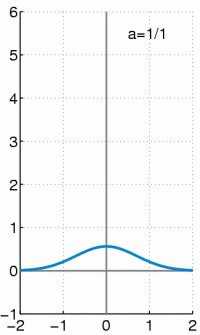
Back دالة ديراك Arabic Дэльта-функцыя Byelorussian Делта-функция Bulgarian ডিরাক ডেল্টা অপেক্ষক Bengali/Bangla Delta de Dirac Catalan Diracovo delta Czech Diracs deltafunktion Danish Delta-Distribution German Κρουστική συνάρτηση Greek Diraka delta funkcio Esperanto


| Differential equations |
|---|
| Scope |
| Classification |
| Solution |
| People |
In mathematical analysis, the Dirac delta function (or δ distribution), also known as the unit impulse,[1] is a generalized function on the real numbers, whose value is zero everywhere except at zero, and whose integral over the entire real line is equal to one.[2][3][4] Thus it can be represented heuristically as
such that
Since there is no function having this property, modelling the delta "function" rigorously involves the use of limits or, as is common in mathematics, measure theory and the theory of distributions.
The delta function was introduced by physicist Paul Dirac, and has since been applied routinely in physics and engineering to model point masses and instantaneous impulses. It is called the delta function because it is a continuous analogue of the Kronecker delta function, which is usually defined on a discrete domain and takes values 0 and 1. The mathematical rigor of the delta function was disputed until Laurent Schwartz developed the theory of distributions, where it is defined as a linear form acting on functions.
- ^ atis 2013, unit impulse.
- ^ Arfken & Weber 2000, p. 84.
- ^ Dirac 1930, §22 The δ function.
- ^ Gelfand & Shilov 1966–1968, Volume I, §1.1.
© MMXXIII Rich X Search. We shall prevail. All rights reserved. Rich X Search



